Transillumination and optical coherence tomography for the detection and diagnosis of enamel caries
- PMID: 33502759
- PMCID: PMC8487162
- DOI: 10.1002/14651858.CD013855
Transillumination and optical coherence tomography for the detection and diagnosis of enamel caries
Abstract
Background: Caries is one of the most prevalent and preventable conditions worldwide. If identified early enough then non-invasive techniques can be applied, and therefore this review focusses on early caries involving the enamel surface of the tooth. The cornerstone of caries detection and diagnosis is a visual and tactile dental examination, although alternative approaches are available. These include illumination-based devices that could potentially support the dental examination. There are three categories of illumination devices that exploit various methods of application and interpretation, each primarily defined by different wavelengths, optical coherence tomography (OCT), near-infrared (NIR), and fibre-optic technology, which incorporates more recently developed digital fibre optics (FOTI/DIFOTI).
Objectives: To estimate the diagnostic test accuracy of different illumination tests for the detection and diagnosis of enamel caries in children or adults. We also planned to explore the following potential sources of heterogeneity: in vitro or in vivo studies with different reference standards; tooth surface (occlusal, proximal, smooth surface, or adjacent to a restoration); single or multiple sites of assessment on a tooth surface; and the prevalence of caries into dentine.
Search methods: Cochrane Oral Health's Information Specialist undertook a search of the following databases: MEDLINE Ovid (1946 to 15 February 2019); Embase Ovid (1980 to 15 February 2019); US National Institutes of Health Ongoing Trials Register (ClinicalTrials.gov, to 15 February 2019); and the World Health Organization International Clinical Trials Registry Platform (to 15 February 2019). We studied reference lists as well as published systematic review articles.
Selection criteria: We included diagnostic accuracy study designs that compared the use of illumination-based devices with a reference standard (histology, enhanced visual examination with or without radiographs, or operative excavation). These included prospective studies that evaluated the diagnostic accuracy of a single index test and studies that directly compared two or more index tests. Both in vitro and in vivo studies of primary and permanent teeth were eligible for inclusion. We excluded studies that explicitly recruited participants with caries into dentine or frank cavitation. We also excluded studies that artificially created carious lesions and those that used an index test during the excavation of dental caries to ascertain the optimum depth of excavation.
Data collection and analysis: Two review authors extracted data independently and in duplicate using a standardised data extraction form and quality assessment based on QUADAS-2 specific to the clinical context. Estimates of diagnostic accuracy were determined using the bivariate hierarchical method to produce summary points of sensitivity and specificity with 95% confidence regions. The comparative accuracy of different illumination devices was conducted based on indirect and direct comparisons between methods. Potential sources of heterogeneity were pre-specified and explored visually and more formally through meta-regression.
Main results: We included 24 datasets from 23 studies that evaluated 16,702 tooth surfaces. NIR was evaluated in 6 datasets (673 tooth surfaces), OCT in 10 datasets (1171 tooth surfaces), and FOTI/DIFOTI in 8 datasets (14,858 tooth surfaces). The participant selection domain had the largest number of studies judged at high risk of bias (16 studies). Conversely, for the index test, reference standard, and flow and timing domains the majority of studies were judged to be at low risk of bias (16, 12, and 16 studies respectively). Concerns regarding the applicability of the evidence were judged as high or unclear for all domains. Notably, 14 studies were judged to be of high concern for participant selection, due to selective participant recruitment, a lack of independent examiners, and the use of an in vitro study design. The summary estimate across all the included illumination devices was sensitivity 0.75 (95% confidence interval (CI) 0.62 to 0.85) and specificity 0.87 (95% CI 0.82 to 0.92), with a diagnostic odds ratio of 21.52 (95% CI 10.89 to 42.48). In a cohort of 1000 tooth surfaces with a prevalence of enamel caries of 57%, this would result in 142 tooth surfaces being classified as disease free when enamel caries was truly present (false negatives), and 56 tooth surfaces being classified as diseased in the absence of enamel caries (false positives). A formal comparison of the accuracy according to device type indicated a difference in sensitivity and/or specificity (Chi2(4) = 34.17, P < 0.01). Further analysis indicated a difference in the sensitivity of the different devices (Chi2(2) = 31.24, P < 0.01) with a higher sensitivity of 0.94 (95% CI 0.88 to 0.97) for OCT compared to NIR 0.58 (95% CI 0.46 to 0.68) and FOTI/DIFOTI 0.47 (95% CI 0.35 to 0.59), but no meaningful difference in specificity (Chi2(2) = 3.47, P = 0.18). In light of these results, we planned to formally assess potential sources of heterogeneity according to device type, but due to the limited number of studies for each device type we were unable to do so. For interpretation, we presented the coupled forest plots for each device type according to the potential source of heterogeneity. We rated the certainty of the evidence as low and downgraded two levels in total due to avoidable and unavoidable study limitations in the design and conduct of studies, indirectness arising from the in vitro studies, and imprecision of the estimates.
Authors' conclusions: Of the devices evaluated, OCT appears to show the most potential, with superior sensitivity to NIR and fibre-optic devices. Its benefit lies as an add-on tool to support the conventional oral examination to confirm borderline cases in cases of clinical uncertainty. OCT is not currently available to the general dental practitioner, and so further research and development are necessary. FOTI and NIR are more readily available and easy to use; however, they show limitations in their ability to detect enamel caries but may be considered successful in the identification of sound teeth. Future studies should strive to avoid research waste by ensuring that recruitment is conducted in such a way as to minimise selection bias and that studies are clearly and comprehensively reported. In terms of applicability, any future studies should be undertaken in a clinical setting that is reflective of the complexities encountered in caries assessment within the oral cavity.
Copyright © 2021 The Cochrane Collaboration. Published by John Wiley & Sons, Ltd.
Conflict of interest statement
Richard Macey: none known. Tanya Walsh: none known. I am an Editor with Cochrane Oral Health. Philip Riley: none known. I am Deputy Co‐ordinating Editor of Cochrane Oral Health. Richard Hogan: I am employed by the Colgate‐Palmolive Company as a Clinical Study Manager. I also hold an Honorary Research Fellow position with The University of Manchester. Anne‐Marie Glenny: none known. I am Co‐ordinating Editor of Cochrane Oral Health. Helen V Worthington: none know. I am Emeritus Co‐ordinating Editor of Cochrane Oral Health. Janet E Clarkson: none known. I am Co‐ordinating Editor of Cochrane Oral Health. David Ricketts: none known.
Figures

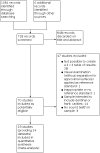

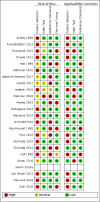



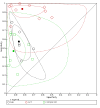
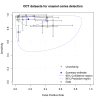

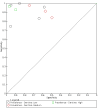

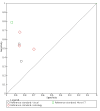

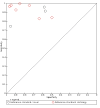

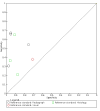
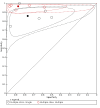






Similar articles
-
Electrical conductance for the detection of dental caries.Cochrane Database Syst Rev. 2021 Mar 16;3(3):CD014547. doi: 10.1002/14651858.CD014547. Cochrane Database Syst Rev. 2021. PMID: 33724442 Free PMC article.
-
Imaging modalities to inform the detection and diagnosis of early caries.Cochrane Database Syst Rev. 2021 Mar 15;3(3):CD014545. doi: 10.1002/14651858.CD014545. Cochrane Database Syst Rev. 2021. PMID: 33720395 Free PMC article.
-
Visual or visual-tactile examination to detect and inform the diagnosis of enamel caries.Cochrane Database Syst Rev. 2021 Jun 14;6(6):CD014546. doi: 10.1002/14651858.CD014546. Cochrane Database Syst Rev. 2021. PMID: 34124773 Free PMC article.
-
Fluorescence devices for the detection of dental caries.Cochrane Database Syst Rev. 2020 Dec 8;12(12):CD013811. doi: 10.1002/14651858.CD013811. Cochrane Database Syst Rev. 2020. PMID: 33319353 Free PMC article.
-
Tests to detect and inform the diagnosis of root caries.Cochrane Database Syst Rev. 2020 Dec 7;12(12):CD013806. doi: 10.1002/14651858.CD013806. Cochrane Database Syst Rev. 2020. PMID: 33284484 Free PMC article.
Cited by
-
Enhancing Oral Cancer Detection: A Systematic Review of the Diagnostic Accuracy and Future Integration of Optical Coherence Tomography with Artificial Intelligence.J Clin Med. 2024 Sep 29;13(19):5822. doi: 10.3390/jcm13195822. J Clin Med. 2024. PMID: 39407882 Free PMC article. Review.
-
Electrical conductance for the detection of dental caries.Cochrane Database Syst Rev. 2021 Mar 16;3(3):CD014547. doi: 10.1002/14651858.CD014547. Cochrane Database Syst Rev. 2021. PMID: 33724442 Free PMC article.
-
Current Infections of the Orofacial Region: Treatment, Diagnosis, and Epidemiology.Life (Basel). 2023 Jan 18;13(2):269. doi: 10.3390/life13020269. Life (Basel). 2023. PMID: 36836626 Free PMC article. Review.
-
Clinical Performance of Diagnostic Methods in Third Molar Teeth with Early Occlusal Caries.Diagnostics (Basel). 2023 Jan 12;13(2):284. doi: 10.3390/diagnostics13020284. Diagnostics (Basel). 2023. PMID: 36673093 Free PMC article.
-
Enamel Caries Detection and Diagnosis: An Analysis of Systematic Reviews.J Dent Res. 2022 Mar;101(3):261-269. doi: 10.1177/00220345211042795. Epub 2021 Oct 12. J Dent Res. 2022. PMID: 34636266 Free PMC article.
References
References to studies included in this review
Ashley 1998 {published data only}
-
- Ashley PF, Blinkhorn AS, Davies RM. Occlusal caries diagnosis: an in vitro histological validation of the Electronic Caries Monitor (ECM) and other methods. Journal of Dentistry 1998;26:83-8. - PubMed
Astvaldsdottir 2012 {published data only}
Bussaneli 2015 {published data only}
-
- Bussaneli DG, Restrepo M, Boldieri T, Pretel H, Mancini MW, Santos-Pinto L, et al. Assessment of a new infrared laser transillumination technology (808 nm) for the detection of occlusal caries - an in vitro study. Lasers in Medical Science 2015;30:1873-9. - PubMed
Chawla 2012 {published data only}
-
- Chawla N, Messer LB, Adams GG, Manton DJ. An in vitro comparison of detection methods for approximal carious lesions in primary molars. Caries Research 2012;46:161-9. - PubMed
Holt 1989 {published data only}
-
- Holt RD, Azevedo MR. Fibre optic transillumination and radiographs in diagnosis of approximal caries in primary teeth. Community Dental Health 1989;6:239-47. - PubMed
Holtzman 2010 {published data only}
Jablonski‐Momeni 2017 {published data only}
Laitala 2017 {published data only}
Lederer 2018 {published data only}
-
- Lederer A, Kunzelmann KH, Hickel R, Litzenburger F. Transillumination and HDR imaging for proximal caries detection. Journal of Dental Research 2018;97:844-9. - PubMed
Mansour 2016 {published data only}
Mialhe 2003 {published data only}
-
- Mialhe FL, Pereira AC, Pardi V, Castro Meneghim M. Comparison of three methods for detection of carious lesions in proximal surfaces versus direct visual examination after tooth separation. Journal of Clinical Pediatric Dentistry 2003;28:59-62. - PubMed
Nakagawa 2013 {published data only}
-
- Nakagawa H, Sadr A, Shimada Y, Tagami J, Sumi Y. Validation of swept source optical coherence tomography (SS-OCT) for the diagnosis of smooth surface caries in vitro. Journal of Dentistry 2013;41:80-9. - PubMed
Nakajima 2014 {published data only}
-
- Nakajima Y, Shimada Y, Sadr A, Wada I, Miyashin M, Takagi Y, et al. Detection of occlusal caries in primary teeth using swept source optical coherence tomography. Journal of Biomedical Optics 2014;19:16020. - PubMed
NCT02657538 {published data only}
-
- NCT02657538. Validation of near-infrared light transillumination for interproximal enamel caries detection [Validation of near-infrared light transillumination for interproximal enamel caries detection: a clinical controlled trial]. clinicaltrials.gov/ct2/show/NCT02657538 (first received 18 January 18 2016).
Obry‐Musset 1988 {published data only}
-
- Obry-Musset AM, Cahen PM, Turlot JC, Frank RM. Approximal caries diagnosis in epidemiological studies: transillumination or bitewing radiographs? Journal de Biologie Buccale 1988;16:13-7. - PubMed
Park 2018 {published data only}
-
- Park KJ, Schneider H, Ziebolz D, Krause F, Haak R. Optical coherence tomography to evaluate variance in the extent of carious lesions in depth. Lasers in Medical Science 2018;33:1573-9. - PubMed
Shimada 2010 {published data only}
-
- Shimada Y, Sadr A, Burrow MF, Tagami J, Ozawa N, Sumi Y. Validation of swept-source optical coherence tomography (SS-OCT) for the diagnosis of occlusal caries. Journal of Dentistry 2010;38:655-65. - PubMed
Shimada 2014 {published data only}
-
- Shimada Y, Nakagawa H, Sadr A, Wada I, Nakajima M, Nikaido T, et al. Non-invasive cross-sectional imaging of proximal caries using swept-source optical coherence tomography (SS-OCT) in vivo. Journal of Biophotonics 2014;7:506-13. - PubMed
Sidi 1988 {published data only}
-
- Sidi AD, Naylor MN. A comparison of bitewing radiography and interdental transillumination as adjuncts to the clinical identification of approximal caries in posterior teeth. British Dental Journal 1988;164:15-8. - PubMed
Simon 2016 {published data only}
Simon 2016a {published data only}
Van Hilsen 2013 {published data only}
Xiao‐Hua 2016 {published data only}
Zain 2018 {published data only}
-
- Zain E, Zakian CM, Chew HP. Influence of the loci of non-cavitated fissure caries on its detection with optical coherence tomography. Journal of Dentistry 2018;71:31-7. - PubMed
References to studies excluded from this review
Baltacioglu 2017 {published data only}
Bin‐Shuwaish 2008 {published data only}
-
- Bin-Shuwaish M, Yaman P, Dennison J, Neiva G. The correlation of DIFOTI to clinical and radiographic images in Class II carious lesions. Journal of the American Dental Association 2008;139:1374-81. - PubMed
Blazejewska 2016 {published data only}
-
- Blazejewska A, Dacyna N, Niesiobedzki P, Trzaska M, Gozdowski D, Turska-Szybka A, et al. Comparison of the detection of proximal caries in children and youth using DIAGNOcam and bitewing radiovisiography. Dental and Medical Problems 2016;53:468-75.
Chesters 2002 {published data only}
-
- Chesters RK, Pitts NB, Matuliene G, Kvedariene A, Huntington E, Bendinskaite R, et al. An abbreviated caries clinical trial design validated over 24 months. Journal of Dental Research 2002;81:637-40. - PubMed
Choksi 1994 {published data only}
-
- Choksi SK, Brady JM, Dang DH, Rao MS. Detecting approximal dental caries with transillumination: a clinical evaluation. Journal of the American Dental Association 1994;125:1098-102. - PubMed
Cortes 2000 {published data only}
-
- Cortes DF, Ekstrand KR, Elias-Boneta AR, Ellwood RP. An in vitro comparison of the ability of fibre-optic transillumination, visual inspection and radiographs to detect occlusal caries and evaluate lesion depth. Caries Research 2000;34:443-7. - PubMed
Cortes 2003 {published data only}
-
- Cortes DF, Ellwood RP, Ekstrand KR. An in vitro comparison of a combined FOTI/visual examination of occlusal caries with other caries diagnostic methods and the effect of stain on their diagnostic performance. Caries Research 2003;37:8-16. - PubMed
da Silva 2011 {published data only}
-
- da Silva RP, Assaf AV, Pereira SM, Mialhe FL, Ambrosano GM, Meneghim Mde C, et al. Validity of caries-detection methods under epidemiological setting. American Journal of Dentistry 2011;24:363-6. - PubMed
Elhennawy 2018 {published data only}
-
- Elhennawy K, Askar H, Jost-Brinkmann PG, Reda S, Al-Abdi A, Paris S, et al. In vitro performance of the DIAGNOcam for detecting proximal carious lesions adjacent to composite restorations. Journal of Dentistry 2018;72:39-43. - PubMed
Gomez 2013 {published data only}
-
- Gomez J, Zakian C, Salsone S, Pinto SCS, Taylor A, Pretty IA, et al. In vitro performance of different methods in detecting occlusal caries lesions. Journal of Dentistry 2013;41(2):180-6. - PubMed
Grossman 2002 {published data only}
-
- Grossman ES, Cleaton-Jones PE, Cortes DF, Daya NP, Parak RB, Fatti LP, et al. Accurate diagnosis of occlusal carious lesions - a stereo microscope evaluation of clinical diagnosis. Journal of the South African Dental Association 2002;57:215-20. - PubMed
Hintze 1998 {published data only}
-
- Hintze H, Wenzel A, Danielsen B, Nyvad B. Reliability of visual examination, fibre-optic transillumination, and bitewing radiography, and reproducibility of direct visual examination following tooth separation for the identification of cavitated carious lesions in contacting approximal surfaces. Caries Research 1998;32:204-9. - PubMed
Holtzman 2014 {published data only}
Holtzman 2015 {published data only}
Ibusuki 2015 {published data only}
-
- Ibusuki T, Kitasako Y, Sadr A, Shimada Y, Sumi Y, Tagami J. Observation of white spot lesions using swept source optical coherence tomography (SS-OCT): in vitro and in vivo study. Dental Materials Journal 2015;34:545-52. - PubMed
Kuhnisch 2016 {published data only}
-
- Kuhnisch J, Sochtig F, Pitchika V, Laubender R, Neuhaus KW, Lussi A, et al. In vivo validation of near-infrared light transillumination for interproximal dentin caries detection. Clinical Oral Investigations 2016;20:821-9. - PubMed
Lara‐Capi 2017 {published data only}
Lederer 2019 {published data only}
-
- Lederer A, Kunzelmann KH, Heck K, Hickel R, Litzenburger F. In vitro validation of near-infrared transillumination at 780 nm for the detection of caries on proximal surfaces. Clinical Oral Investigations 2019;23(11):3933-40. - PubMed
Lee 2009 {published data only}
Lee 2010 {published data only}
Lee 2010a {published data only}
Manton 2007 {published data only}
-
- Manton DJ, Messer LB. The effect of pit and fissure sealants on the detection of occlusal caries in vitro. European Archives of Paediatric Dentistry 2007;8:43-8. - PubMed
Marianska 2015 {published data only}
-
- Marianska I, Gontarz W, Pedzisz M, Turska-Szybka A, Olczak-Kowalczyk D. Identification and stage of severity of caries on proximal surfaces of deciduous teeth. Dental and Medical Problems 2015;52:39-46.
Marinova‐Takorova 2014 {published data only}
-
- Marinova-Takorova M, Anastasova R, Panov VE. Comparative evaluation of the effectiveness of five methods for early diagnosis of occlusal caries lesions - in vitro study. Journal of IMAB - Annual Proceeding (Scientific Papers) 2014;20:533-6.
Matsuura 2018 {published data only}
-
- Matsuura C, Shimada Y, Sadr A, Sumi Y, Tagami J. Three-dimensional diagnosis of dentin caries beneath composite restorations using swept-source optical coherence tomography. Dental Materials Journal 2018;37:642-9. - PubMed
Mialhe 2009 {published data only}
-
- Mialhe FL, Pereira AC, Meneghim Mde C, Ambrosano GM, Pardi V. The relative diagnostic yields of clinical, FOTI and radiographic examinations for the detection of approximal caries in youngsters. Indian Journal of Dental Research 2009;20:136-40. - PubMed
Mitropoulos 1985 {published data only}
-
- Mitropoulos CM. A comparison of fibre-optic transillumination with bitewing radiographs. British Dental Journal 1985;159:21-3. - PubMed
Mitropoulos 1985a {published data only}
-
- Mitropoulos CM. The use of fibre-optic transillumination in the diagnosis of posterior approximal caries in clinical trials. Caries Research 1985;19:379-84. - PubMed
Ozkan 2017 {published data only}
-
- Ozkan G, Guzel KGU. Clinical evaluation of near-infrared light transillumination in approximal dentin caries detection. Lasers in Medical Science 2017;32(6):1417-22. - PubMed
Purdell‐Lewis 1974 {published data only}
-
- Purdell-Lewis DJ, Pot T. A comparison of radiographic and fibre-optic diagnoses of approximal caries lesions. Journal of Dentistry 1974;2:143-8. - PubMed
Salsone 2012 {published data only}
-
- Salsone S, Taylor A, Gomez J, Pretty I, Ellwood R, Dickinson M, et al. Histological validation of near-infrared reflectance multispectral imaging technique for caries detection and quantification. Journal of Biomedical Optics 2012;17:076009. - PubMed
Sasazawa 2015 {published data only}
-
- Sasazawa S, Kakino S, Matsuura Y. Optical-fiber-based laser-induced breakdown spectroscopy for detection of early caries. Journal of Biomedical Optics 2015;20:065002. - PubMed
Schaefer 2018 {published data only}
-
- Schaefer G, Pitchika V, Litzenburger F, Hickel R, Kühnisch J. Evaluation of occlusal caries detection and assessment by visual inspection, digital bitewing radiography and near-infrared light transillumination. Clinical Oral Investigations 2018;22(7):2431-8. - PubMed
Schneiderman 1997 {published data only}
-
- Schneiderman A, Elbaum M, Shultz T, Keem S, Greenebaum M, Driller J. Assessment of dental caries with digital imaging fiber-optic transIllumination (DIFOTI): in vitro study. Caries Research 1997;31:103-10. - PubMed
Simon 2014 {published data only}
Simon 2018 {published data only}
Sochtig 2014 {published data only}
-
- Sochtig F, Hickel R, Kuhnisch J. Caries detection and diagnostics with near-infrared light transillumination: clinical experiences. Quintessence International 2014;45:531-8. - PubMed
Staninec 2010 {published data only}
Staninec 2011 {published data only}
Stephen 1987 {published data only}
-
- Stephen KW, Russell JI, Creanor SL, Burchell CK. Comparison of fibre optic transillumination with clinical and radiographic caries diagnosis. Community Dentistry and Oral Epidemiology 1987;15:90-4. - PubMed
Tetschke 2018 {published data only}
-
- Tetschke F, Kirsten L, Golde J, Walther J, Galli R, Koch E, et al. Application of optical and spectroscopic technologies for the characterization of carious lesions in vitro. Biomedizinische Technik [Biomedical Engineering] 2018;63:595-602. - PubMed
Verdonschot 1991 {published data only}
-
- Verdonschot EH, de Rijke JW, Brouwer W, ten Bosch JJ, Truin GJ. Optical quantitation and radiographic diagnosis of incipient approximal caries lesions. Caries Research 1991;25:359-64. - PubMed
Verdonschot 1992 {published data only}
-
- Verdonschot EH, Bronkhorst EM, Burgersdijk RC, Konig KG, Schaeken MJ, Truin GJ. Performance of some diagnostic systems in examinations for small occlusal carious lesions. Caries Research 1992;26:59-64. - PubMed
Waly 1995 {published data only}
-
- Waly NG. Evaluation of three diagnostic methods for initial proximal caries detection in primary molars. Egyptian Dental Journal 1995;41:1441-9. - PubMed
Wenzel 1992 {published data only}
-
- Wenzel A, Verdonschot EH, Truin GJ, Konig KG. Accuracy of visual inspection, fiber-optic transillumination, and various radiographic image modalities for the detection of occlusal caries in extracted non-cavitated teeth. Journal of Dental Research 1992;71:1934-7. - PubMed
Wilder‐Smith 2013 {published data only}
-
- Wilder-Smith P, Holtzman J, Fontana M, Ballantine J, Calantog A, Wang A, et al. Development and validation of a caries diagnostic algorithm. Lasers in Surgery and Medicine 2013;45:274.
Yu 2017 {published data only}
-
- Yu JL, Tang RT, Feng L, Dong YM. Digital imaging fiber optic transillumination (DIFOTI) method for determining the depth of cavity. Beijing Da Xue Xue Bao [Journal of Peking University. Health sciences] 2017;49:81-5. - PubMed
Zakian 2009 {published data only}
-
- Zakian C, Pretty I, Ellwood R. Near-infrared hyperspectral imaging of teeth for dental caries detection. Journal of Biomedical Optics 2009;14:064047. - PubMed
Additional references
Anaise 1984
-
- Anaise JZ. Measurement of dental caries experience - modification of the DMFT index. Community Dentistry and Oral Epidemiology 1984;12(1):43-6. - PubMed
Angmar‐Månsson 2001
-
- Angmar-Månsson B, Ten Bosch JJ. Quantitative light-induced fluorescence (QLF): a method for assessment of incipient caries lesions. Dento Maxillo Facial Radiology 2001;30:298-307. - PubMed
Backer Dirks 1951
-
- Backer Dirks O, Van Amerongen J, Winkler KC. A reproducible method for caries evaluation. Journal of Dental Research 1951;30:346-59. - PubMed
Bader 2002
-
- Bader JD, Shugars DA, Bonito AJ. A systematic review of the performance of methods for identifying carious lesions. Journal of Public Health Dentistry 2002;62(4):201-13. - PubMed
Bakhshandeh 2018
-
- Bakhshandeh A, Floriano I, Braga MM, Thorlacius KA, Ekstrand KR. Relationship between depth of approximal caries lesions and presence of bacteria in the dentine in primary and permanent posterior teeth: a radiographic examination with microbiological evaluation. Acta Odontologica Scandinavica 2018;76(7):509-14. - PubMed
Bates 2007
-
- Bates D, Sarkar D, Bates MD, Matrix L. The lme4 package. R Package Version 2007;2(1):74.
Bloemendal 2004
-
- Bloemendal E, De Vet HC, Bouter LM. The value of bitewing radiographs in epidemiological caries research: a systematic review of the literature. Journal of Dentistry 2004;32:255-64. - PubMed
Bossuyt 2003
-
- Bossuyt PM, Reitsma JB, Bruns DE, Gatsonis CA, Glasziou PP, Irwig LM, et al. The STARD statement for reporting studies of diagnostic accuracy: explanation and elaboration. Annals of Internal Medicine 2003;138(1):W1-12. - PubMed
Braga 2009
-
- Braga MM, Oliveira LB, Bonini GAVC, Bönecker M, Mendes FM. Feasibility of the International Caries Detection and Assessment System (ICDAS-II) in epidemiological surveys and comparability with standard World Health Organization criteria. Caries Research 2009;43:245-9. - PubMed
Broadbent 2008
Cohen 2015
Davies 2001
-
- Davies GM, Worthington HV, Clarkson JE, Thomas P, Davies RM. The use of fibre-optic transillumination in general dental practice. British Dental Journal 2001;191:145. - PubMed
Deeks 2005
-
- Deeks JJ, Macaskill P, Irwig L. The performance of tests of publication bias and other sample size effects in systematic reviews of diagnostic test accuracy was assessed. Journal of Clinical Epidemiology 2005;58(9):882-93. - PubMed
Deeks 2013
-
- Deeks JJ, Bossuyt PM, Gatsonis C, editor(s). Cochrane Handbook for Systematic Reviews of Diagnostic Test Accuracy Version 1.0.0. The Cochrane Collaboration, 2013. Available from srdta.cochrane.org.
de Vet 2008
-
- Vet HCW, Eisinga A, Riphagen II, Aertgeerts B, Pewsner D. Chapter 7: Searching for studies. In: Cochrane Handbook for Systematic Reviews of Diagnostic Test Accuracy Version 0.4 (updated September 2008). The Cochrane Collaboration, 2008. Available from srdta.cochrane.org.
Dinnes 2016
Downer 1975
-
- Downer MC. Concurrent validity of an epidemiological diagnostic system for caries with the histological appearance of extracted teeth as validating criterion. Caries Research 1975;9:231-46. - PubMed
Dye 2015
-
- Dye BA, Thornton-Evans G, Li X, Iafolla TJ. Dental caries and sealant prevalence in children and adolescents in the United States, 2011-2012. NCHS Data Brief 2015;(191):1-8. - PubMed
Ekstrand 1997
-
- Ekstrand KR, Ricketts DNJ, Kidd EAM. Reproducibility and accuracy of three methods for assessment of demineralization depth on the occlusal surface: an in vitro examination. Caries Research 1997;31:224-31. - PubMed
Ekstrand 1998
-
- Ekstrand KR, Ricketts DNJ, Kidd EAM, Qvist V, Schou S. Detection, diagnosing, monitoring and logical treatment of occlusal caries in relation to lesion activity and severity: an in vivo examination with histological validation. Caries Research 1998;32:247-54. - PubMed
Ekstrand 2007
-
- Ekstrand KR, Martignon S, Ricketts DJN, Qvist V. Detection and activity assessment of primary coronal caries lesions: a methodologic study. Operative Dentistry 2007;32(3):225-35. - PubMed
Ellwood 1997
-
- Ellwood RP, Davies RM, Worthington HV. Evaluation of a dental subtraction radiography system. Journal of Periodontal Research 1997;32:241-8. - PubMed
Featherstone 2004
-
- Featherstone JDB. The continuum of dental caries - evidence for a dynamic disease process. Journal of Dental Research 2004;83:39-42. - PubMed
Feigin 2016
Fejerskov 2015
-
- Fejerskov O, Nyvad B, Kidd E, editor(s). Dental Caries: the Disease and its Clinical Management. 3rd edition. Wiley-Blackwell, 2015.
Freeman 2019
Fried 2019
-
- Fried D. Optical coherence tomography for imaging dental caries. In: Ferreira Zandona A, Longbottom C, editors(s). Detection and Assessment of Dental Caries. Springer, Cham, 2019:199-208.
Fyffe 2000
-
- Fyffe HE, Deery C, Nugent ZJ, Nuttall NM, Pitts NB. Effect of diagnostic threshold on the validity and reliability of epidemiological caries diagnosis using the Dundee Selectable Threshold Method for caries diagnosis (DSTM). Community Dentistry and Oral Epidemiology 2000;28:42-51. - PubMed
Hall‐Scullin 2017
-
- Hall-Scullin E, Whitehead H, Milsom K, Tickle M, Su T-L, Walsh T. Longitudinal study of caries development from childhood to adolescence. Journal of Dental Research 2017;96:762-7. - PubMed
Hogan 2019
-
- Hogan R, Pretty IA, Ellwood RP. Fibre-optic transillumination: FOTI. In: Ferreira Zandona A, Longbottom C, editors(s). Detection and Assessment of Dental Caries. Springer, Cham, 2019:139-50.
Horner 2009
-
- Horner K, Islam M, Flygare L, Tsiklakis K, Whaites E. Basic principles for use of dental cone beam computed tomography: consensus guidelines of the European Academy of Dental and Maxillofacial Radiology. Dento Maxillo Facial Radiology 2009;38:187-95. - PubMed
Hse 2015
-
- Hse K. The challenge of oral disease - a call for global action. In: The Oral Health Atlas. 2nd edition. Geneva: FDI World Dental Federation, 2015:8-11.
Ismail 2004
-
- Ismail AI. Visual and visuo-tactile detection of dental caries. Journal of Dental Research 2004;83:56-66. - PubMed
Ismail 2007
-
- Ismail AI, Sohn W, Tellez M, Amaya A, Sen A, Hasson H, et al. The International Caries Detection and Assessment System (ICDAS): an integrated system for measuring dental caries. Community Dentistry and Oral Epidemiology 2007;35:170-8. - PubMed
Ismail 2013
-
- Ismail AI, Tellez M, Pitts NB, Ekstrand KR, Ricketts D, Longbottom C, et al. Caries management pathways preserve dental tissues and promote oral health. Community Dentistry and Oral Epidemiology 2013;41(1):e12-40. - PubMed
Ismail 2015
Jones 2017
-
- Jones CM, Davies GM, Monaghan N, Morgan MZ, Neville JS, Pitts NB. The caries experience of 5 year-old children in Scotland in 2013-2014, and in England and Wales in 2014-2015. Reports of cross-sectional dental surveys using BASCD criteria. Community Dental Health 2017;34:157-62. - PubMed
Kassebaum 2015
-
- Kassebaum NJ, Bernabé E, Dahiya M, Bhandari B, Murray CJL, Marcenes W. Global burden of untreated caries: a systematic review and metaregression. Journal of Dental Research 2015;94:650-8. - PubMed
Kidd 2004
-
- Kidd EAM, Fejerskov O. What constitutes dental caries? Histopathology of carious enamel and dentin related to the action of cariogenic biofilms. Journal of Dental Research 2004;83:35-8. - PubMed
Kidd 2016
-
- Kidd EAM, Fejerskov O. Essentials of Dental Caries. 4th edition. Oxford University Press, 2016.
Kühnisch 2019
-
- Kühnisch J. Near-infrared light transillumination. In: Ferreira Zandona A, Longbottom C, editors(s). Detection and Assessment of Dental Caries. Springer, Cham, 2019:151-8.
Leeflang 2008
Listl 2015
-
- Listl S, Galloway J, Mossey PA, Marcenes W. Global economic impact of dental diseases. Journal of Dental Research 2015;94:1355-61. - PubMed
Macaskill 2010
-
- Macaskill P, Gatsonis C, Deeks JJ, Harbord RM, Takwoingi Y. Chapter 10: Analysing and presenting results. In: Deeks JJ, Bossuyt PM, Gatsonis C, editor(s). Cochrane Handbook for Systematic Reviews of Diagnostic Test Accuracy Version 1.0. The Cochrane Collaboration, 2010. Available from srdta.cochrane.org.
Macey 2018
-
- Macey R, Walsh T, Riley P, Glenny AM, Worthington H, Clarkson J, et al. Tests to detect and inform the diagnosis of caries. Cochrane Database of Systematic Reviews 2018, Issue 12. Art. No: CD013215. [DOI: 10.1002/14651858.CD013215] - DOI
Macey 2020
Martignon 2019
-
- Martignon S, Pitts NB, Goffin G, Mazevet M, Douglas GVA, Newton JT, et al. CariesCare practice guide: consensus on evidence into practice. British Dental Journal 2019;227(5):353-62. - PubMed
Matos 2011
-
- Matos R, Novaes TF, Braga MM, Siqueira WL, Duarte DA, Mendes FM. Clinical performance of two fluorescence-based methods in detecting occlusal caries lesions in primary teeth. Caries Research 2011;45:294-302. - PubMed
McInnes 2018
-
- McInnes MDF, Moher D, Thombs BD, McGrath TA, Bossuyt PM, Clifford T, et al. Preferred Reporting Items for a Systematic Review and Meta-analysis of Diagnostic Test Accuracy Studies: The PRISMA-DTA Statement. JAMA 2018;319:388-96. - PubMed
Milsom 2003
-
- Milsom KM, Tickle M, Humphris GM, Blinkhorn AS. The relationship between anxiety and dental treatment experience in 5-year-old children. British Dental Journal 2003;194:503. - PubMed
Nyvad 1997
-
- Nyvad B, Fejerskov O. Assessing the stage of caries lesion activity on the basis of clinical and microbiological examination. Community Dentistry and Oral Epidemiology 1997;25:69-75. - PubMed
Partlett 2016
-
- Partlett C, Takwoingi Y. Meta-analysis of test accuracy studies in R: a summary of user-written programs and step-by-step guide to using glmer Version 1.0. srdta.cochrane.org/ 2016.
Petersen 2005
Pitts 1988
-
- Pitts NB, Fyffe HE. The effect of varying diagnostic thresholds upon clinical caries data for a low prevalence group. Journal of Dental Research 1988;67:592-6. - PubMed
Pitts 2001
-
- Pitts NB. Clinical diagnosis of dental caries: a European perspective. Journal of Dental Education 2001;65:972-8. - PubMed
Pitts 2009
-
- Pitts N. Detection, Assessment, Diagnosis and Monitoring of Caries. Switzerland: Karger Basel, 2009.
Pitts 2017
-
- Pitts NB, Zero DT, Marsh PD, Ekstrand K, Weintraub JA, Ramos-Gomez F, et al. Dental caries. Nature Reviews Disease Primers 2017;3:17030. - PubMed
Pretty 2006
-
- Pretty IA. Caries detection and diagnosis: novel technologies. Journal of Dentistry 2006;34:727-39. - PubMed
Public Health England 2014
-
- Public Health England. Oral health survey of five-year-old. Dental public health epidemiology programme. www.nwph.net/dentalhealth/14_15_5yearold/Protocol_2014_15_5%20yr%20olds%... (accessed 15 May 2018).
Reitsma 2005
-
- Reitsma JB, Glas AS, Rutjes AWS, Scholten RJPM, Bossuyt PM, Zwinderman AH. Bivariate analysis of sensitivity and specificity produces informative summary measures in diagnostic reviews. Journal of Clinical Epidemiology 2005;58:982-90. - PubMed
Review Manager 2020 [Computer program]
-
- Review Manager 5 (RevMan 5). Version 5.4. Copenhagen: Nordic Cochrane Centre, The Cochrane Collaboration, 2020.
Rutter 2001
-
- Rutter CM, Gatsonis CA. A hierarchical regression approach to meta-analysis of diagnostic test accuracy evaluations. Statistics in Medicine 2001;20(19):2865-84. - PubMed
Schünemann 2020
-
- Schünemann HJ, Mustafa RA, Brozek J, Steingart KR, Leeflang M, Murad MH, et al. GRADE guidelines: 21 part 1. Study design, risk of bias, and indirectness in rating the certainty across a body of evidence for test accuracy. Journal of Clinical Epidemiology 2020;122:129-41. - PubMed
Schünemann 2020a
-
- Schünemann HJ, Mustafa RA, Brozek J, Steingart KR, Leeflang M, Murad MH, et al. GRADE guidelines: 21 part 2. Test accuracy: inconsistency, imprecision, publication bias, and other domains for rating the certainty of evidence and presenting it in evidence profiles and summary of findings tables. Journal of Clinical Epidemiology 2020;122:142-52. - PubMed
Shoaib 2009
-
- Shoaib L, Deery CM, Ricketts DNJ, Nugent ZJ. Validity and reproducibility of ICDAS II in primary teeth. Caries Research 2009;43:442-8. - PubMed
Steele 2011
-
- Steele J, O’Sullivan I. Executive summary: Adult Dental Health Survey 2009. files.digital.nhs.uk/publicationimport/pub01xxx/pub01086/adul-dent-heal-... 2011.
Takwoingi 2013
-
- Takwoingi Y, Leeflang MM, Deeks JJ. Empirical evidence of the importance of comparative studies of diagnostic test accuracy. Annals of Internal Medicine 2013;158(7):544-54. - PubMed
Tam 2001
-
- Tam LE, McComb D. Diagnosis of occlusal caries: Part II. Recent diagnostic technologies. Journal of the Canadian Dental Association 2001;67:459-64. - PubMed
Thomson 2000
-
- Thomson WM, Locker D, Poulton R. Incidence of dental anxiety in young adults in relation to dental treatment experience. Community Dentistry and Oral Epidemiology 2000;28:289-94. - PubMed
Vernazza 2016
Wenzel 1995
-
- Wenzel A, Gröndahl HG. Direct digital radiography in the dental office. International Dental Journal 1995;45:27-34. - PubMed
Wenzel 2000
-
- Wenzel A, Anthonisen PN, Juul MB. Reproducibility in the assessment of caries lesion behaviour: a comparison between conventional film and subtraction radiography. Caries Research 2000;34:214-8. - PubMed
Wenzel 2004
-
- Wenzel A. Bitewing and digital bitewing radiography for detection of caries lesions. Journal of Dental Research 2004;83:72-5. - PubMed
Wenzel 2006
-
- Wenzel A. A review of dentists' use of digital radiography and caries diagnosis with digital systems. Dento Maxillo Facial Radiology 2006;35:307-14. - PubMed
Whaites 2013
-
- Whaites E, Drage N. Essentials of Dental Radiography and Radiology. 5th edition. Churchill Livingstone Elsevier, 2013.
White 2012
-
- White DA, Tsakos G, Pitts NB, Fuller E, Douglas GVA, Murray JJ, et al. Adult Dental Health Survey 2009: common oral health conditions and their impact on the population. British Dental Journal 2012;213(11):567. - PubMed
Whiting 2011
-
- Whiting PF, Rutjes AWS, Westwood ME, Mallett S, Deeks JJ, Reitsma JB, et al. QUADAS-2: a revised tool for the quality assessment of diagnostic accuracy studies. Annals of Internal Medicine 2011;155:529-36. - PubMed
Wilson 1968
-
- Wilson JMG, Jungner G, World Health Organization. Principles and Practice of Screening for Disease. Geneva: World Health Organization, 1968.
World Health Organization 2017
-
- World Health Organization. Sugars and dental caries. WHO Technical Information Note. apps.who.int/iris/bitstream/handle/10665/259413/WHO-NMH-NHD-17.12-eng.pd... (accessed 15 May 2018).
Publication types
MeSH terms
Grants and funding
LinkOut - more resources
Full Text Sources
Other Literature Sources
Medical
Miscellaneous

